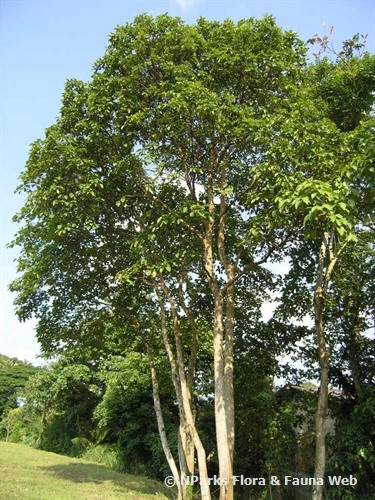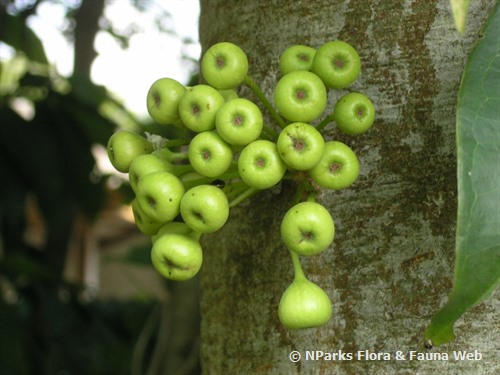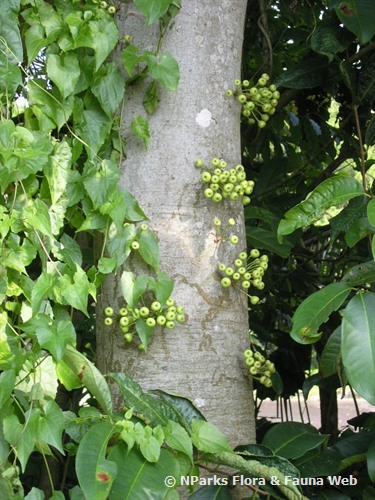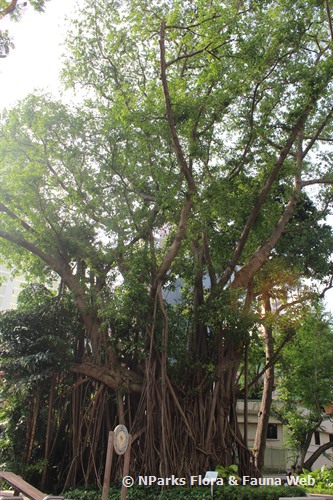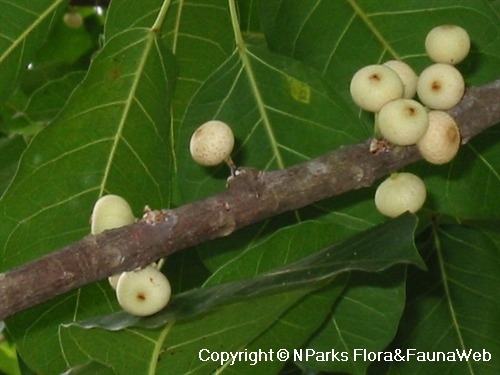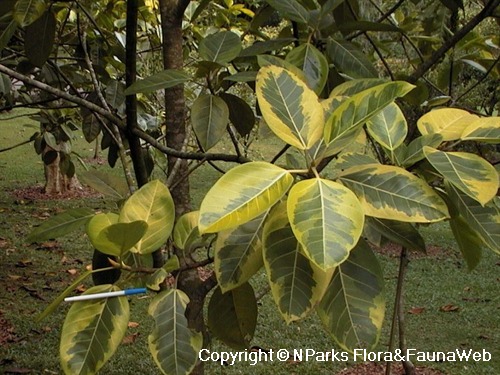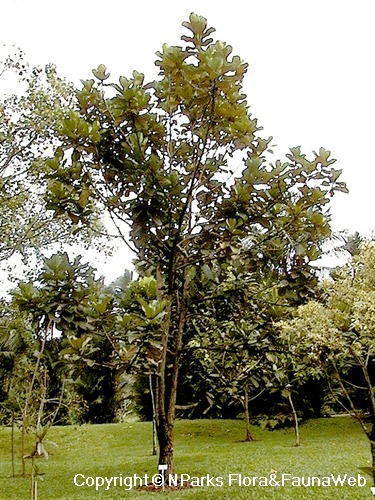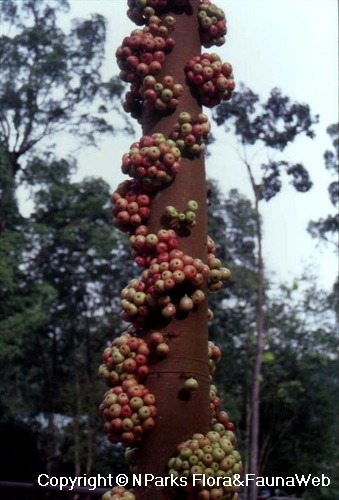
Back
Ficus variegata Blume
| Family Name: | Moraceae |
| Synonyms: | Ficus polysyce Ridl. |
| Common Name: | Common Red-stem Fig, Variegated fig, Variegated rubber plant, Ara kelumpang, 青果榕, 杂色榕 |
Ficus variegata or Common Red-stem Fig is a deciduous tree native to Singapore. Reaching 40 m tall, it produces egg-shaped, elliptic to elongated leaves. Figs are pink or red, and can be found in clusters on thick, rough stalks along the branches and trunk. This keystone species supports numerous fauna such as their fig wasp pollinator, Ceratosolen appendiculatus. Ripe figs are food for plantain squirrels and long-tailed macaques. The species is also a host plant for the butterfly, Mecodina lanceola.
Name
Classifications and Characteristics
| Plant Division | Angiosperms (Flowering Seed Plants) (Dicotyledon) |
|---|---|
| Plant Growth Form | Tree (Big (>30m)) |
| Lifespan (in Singapore) | Perennial |
| Mode of Nutrition | Autotrophic |
| Plant Shape | Conical |
Biogeography
| Native Distribution | India, Andaman Islands, Myanmar, south China, Taiwan, Ryukyu Islands, Indochina, Thailand, Malesia (including Singapore), Solomon Islands, and Australia |
|---|---|
| Native Habitat | Terrestrial (Primary Rainforest, Secondary Rainforest, Freshwater Swamp Forest, Disturbed Area / Open Ground) |
| Preferred Climate Zone | Tropical |
| Local Conservation Status | Native to Singapore (Least Concern (LC)) |
Description and Ethnobotany
| Growth Form | It is a medium-sized tree up to 40 m tall, with a conical crown. It has conspicuous and spreading buttresses developing from its trunk. The plant is easy to identify when it bears syconia (figs). |
|---|---|
| Crown | Conical |
| Roots | Spreading buttresses |
| Foliage | Its spirally arranged, long-stalked leaves have leathery leaf blades that are egg-shaped to oval to oblong with pointed tips, and 6–35 by 2–15 cm. Its young leaves have larger, toothed leaf blades. |
| Flowers | The plant is dioecious with each plant bearing male or female flowers. The flowers are tiny and develop within the syconium (fig). |
| Fruit | Its long-stalked syconia (figs) are pear-shaped, green with rose-red streaks when ripe, up to 5 cm wide, and develop in dense clusters on short twigs, up to 7.6 cm long, arising from the trunk and main branches. It has been observed that only trees that are taller than 5–7.6 m bear figs. |
| Habitat | It grows in villages, along the edges or in open areas in lowland forests up to 1,200 m altitude. It occurs locally in Fort Canning Park and Pulau Ubin. |
| Associated Fauna | Its flowers are pollinated by the fig wasp (Ceratosolen appendiculatus), and its ripe syconia are eaten by birds. |
| Cultivation | It can be propagated by seed. |
| Etymology | Latin Ficus, the commercial edible fig (Ficus carica); Latin variegata, irregularly coloured, referring to the ripening figs that are green with rose-red streaks |
| Ethnobotanical Uses | Medicinal: The latex from the bark are reportedly used as a poultice on wounds. Others: The fibrous bark was previously used to make felt, that is in turn used to make loincloth. |
Landscaping Features
| Landscaping | The tree is attractive when it bears figs, as its trunk and branches will be densely covered with its green or rose-red figs. |
|---|---|
| Desirable Plant Features | Ornamental Fruits |
| Landscape Uses | General, Suitable for Roadsides, Parks & Gardens, Small Gardens |
Fauna, Pollination and Dispersal
| Fauna Pollination Dispersal Associated Fauna | Bird-Attracting |
|---|---|
| Pollination Method(s) | Biotic (Fauna) |
| Seed or Spore Dispersal | Biotic (Fauna) (Vertebrates (Other Mammal)) |
Plant Care and Propagation
| Light Preference | Full Sun, Semi-Shade |
|---|---|
| Water Preference | Moderate Water |
| Plant Growth Rate | Moderate |
| Rootzone Tolerance | Moist Soils, Well-Drained Soils |
| Propagation Method | Seed |
Foliar
| Foliage Retention | Evergreen |
|---|---|
| Mature Foliage Colour(s) | Green |
| Mature Foliage Texture(s) | Leathery |
| Foliar Type | Simple / Unifoliate |
| Foliar Arrangement Along Stem | Alternate, Spiral |
| Foliar Attachment to Stem | Petiolate |
| Foliar Shape(s) | Non-Palm Foliage |
| Foliar Venation | Pinnate / Net |
| Foliar Margin | Entire |
| Leaf Area Index (LAI) for Green Plot Ratio | 3.0 (Tree - Intermediate Canopy) |
Floral (Angiosperm)
| Flower & Plant Sexuality | Unisexual Flowers , Dioecious |
| Flower Grouping | Cluster / Inflorescence |
|---|
| Flower Location | Cauliflorous |
| Inflorescence Type | Syconium |
Fruit, Seed and Spore
| Mature Fruit Colour(s) | Red, Orange |
|---|---|
| Fruit Classification | Multiple Fruit |
| Fruit Type | Fleshy Fruit , Accessory / False Fruit (Pseudocarp) |
Image Repository
Others
| Master ID | 1624 |
|---|---|
| Species ID | 2917 |
| Flora Disclaimer | The information in this website has been compiled from reliable sources, such as reference works on medicinal plants. It is not a substitute for medical advice or treatment and NParks does not purport to provide any medical advice. Readers should always consult his/her physician before using or consuming a plant for medicinal purposes. |

